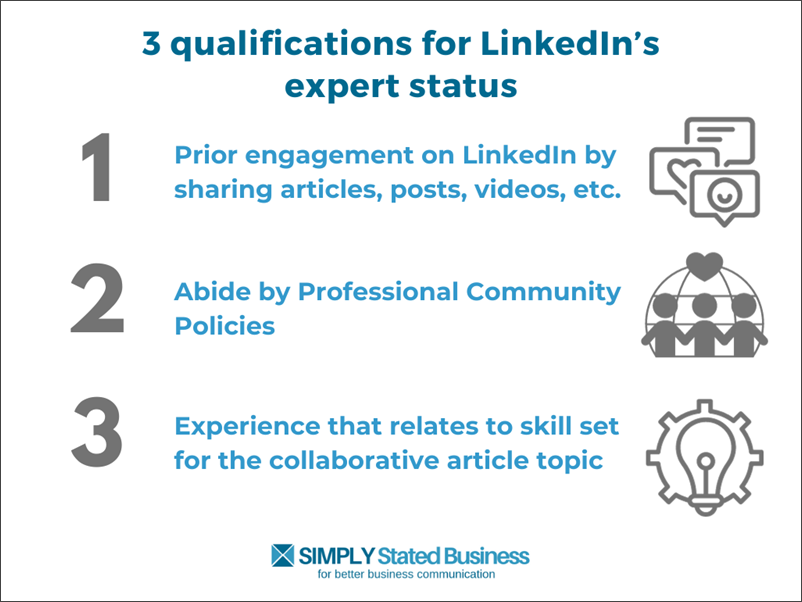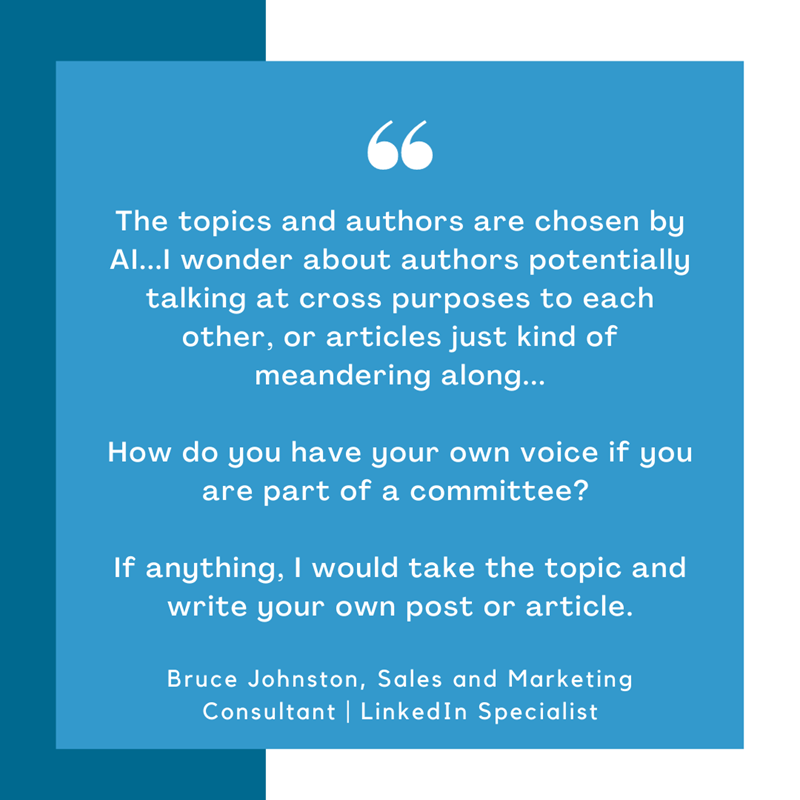
Did you ever imagine collaborating with artificial intelligence (AI)? Strange bedfellows indeed.
AI infiltrates our online world from search engines to articles and the images we view. So, who is really in control?
Perhaps to prove it’s the humans running the show, various platforms are asking us to join forces with AI. One approach is through collaborative articles.
- But what’s in it for the human?
- Does content collaboration make sense?
- Or is it a waste of your valuable time?
=====================================
Table of Contents
========================================
How do AI Collaborative Articles Work?
Collaborative articles using AI are the brainchild of LinkedIn. The networking platform introduced them in March 2023. However, don’t feel bad if you didn’t notice. I only saw a passing reference to the concept.
For whatever reason, LinkedIn launched with little notice. However, the platform appears to be committed to its latest feature. If you look at the sign in page, LinkedIn puts Articles first in its Menu items. A click on the item takes you to a list of collaborative articles.

You can also find the list of topics on the Skilled Pages.
Below is an illustration of LinkedIn’s explanation of how its latest feature works.

Recently, I received an invitation to collaborate on two AI-generated articles. The following are my early thoughts on the topics, experts, and the AI-generated content.
Article Topics
At last look, LinkedIn lists nearly 150 categories for its articles. Although that list grows regularly, I did a quick check on individual articles only in the Communications category.

Some questions are a head scratcher.
The topics I scanned were all in the form of a question. But a few of them had me scratching my head, such as the following.
Example #1 – How can you convey sincerity and trustworthiness through eye contact?
How much can you write about eye contact? Of course, AI had no problem spitting out content.
- Why eye contact matters
- How to make eye contact in interviews…in presentations…in negotiations
- How to adapt eye contact to different cultures
- How to improve your eye contact skills
- Here’s what else to consider.
Currently, 54 experts contributed to the collaborative article. My question is – does the in-depth article add value? Or could it be a talking point in an article about connecting with your audience?
Example #2 – How can you improve an executive’s storytelling skills?
Is the point about coaching the executive or improving storytelling skills? If you read the AI-generated copy, it’s the latter. Maybe the lack of clarity is why there were no contributions to the article.
Observation #1 – Some topic questions lack clarity and value.
Topic Experts
The following only relates to my selection as an “expert.” I was invited to contribute to the following two articles.
- What are the most common mistakes to avoid when using storytelling for change management?
- What are effective communication strategies for patient advocates in cross-functional coordination?
This part of the process is a bit hazy for me. My understanding is you can contribute if you have the following background.

It also appears that you can select a topic and if you see the “Add your perspective” box (as illustrated below), you can contribute that way, too.

Apparently, if the box is not shown, you are not deemed an “expert” for that topic.
My Topic Questions
The two topic questions sent to me relate to a corporate and health care setting. While that’s in my background, I’ve never been a patient advocate, but I have worked with them.
No one has contributed to the patient advocate question so far. It seems to me that someone with experience as a patient advocate would have the best perspective.
On the other hand, good communication is good communication. I know. Profound statement. 🙂 However, I question what the final product will look like with so many different perspectives.
Will the final product become a mishmash of ideas leading to a confused tangle of words?
Observation #2 – Wide range of perspectives may confuse and result in disjointed article.
AI-generated Content
To jump-start the discussion, LinkedIn uses AI to generate content for the selected topic. Typically, AI produces an introduction, followed by five to six talking points.
For example, the article for common storytelling mistakes (when used for change management) contained the following talking points.
Lack of:
- clarity
- relevance
- authenticity
- diversity
- action
And closed with “This is what else to consider” paragraph.
Something that was not immediately clear to me was contributors add their perspective next to the talking point they’re addressing. Okay, this may be my bad as the box shown above (and below) told me that. Duh.

So, you could add your perspective to one or all six sections in the above example.
AI Talking Points
Now, here’s another head-scratcher for me. What if I don’t like the six talking points? Or I like some but not all?
I have played with AI a bit to learn more about it. I don’t claim to be an AI expert by any stretch of the imagination. But I have found the AI-generated content may offer good ideas or talking points. But while I would use some of the points, I would do almost a complete rewrite on content.
I’m not sure what (if anything) LinkedIn plans to do with the articles after experts add their perspective. If left in its current format, it’s like comments on a social media post (without the controversy).
Observation #3 – AI appears to be driving the bus and the humans are along for the ride.
What’s in it for the Humans?
Badges
If you’re into this kind of validation, LinkedIn dangles recognition through a Top Voices badge. Unlike LinkedIn’s Top Voices badge that is by invitation only, the Community Top Voices badge is earned through the community and collaboration on the articles.
You earn the badge based on skills shown on collaborative articles (presumably through community engagement and reactions).
There is no limit to the number of skills you can qualify for (although you get only one badge). The badge is active for 60 days, but you can retain the badge past 60 days if you keep contributing and are recognized for skills.
I took a screenshot of an expert so you can see what it looks like – on his profile and next to his contributions to articles.
Top Voice Badge for Profile

Top Voice Badge on Article Contributions

Increased Visibility (or so they say)
As a longtime professional business writer, I struggle to keep skepticism out of discussions regarding increased visibility. More than one company used that as a lure for me to write for them without compensation.
And the other factor that has me taking this “reward” with a grain of salt is knowing who is in charge of the algorithms. Hint: It’s not you and me.
So, to receive that cherished visibility, you either need an inside track or a HUGE investment of your time collaborating with AI articles. And even then, it’s no guarantee.
So, is it worth it?
When I first received the invitation, I contacted LinkedIn specialist, Bruce Johnston. Bruce summed up my initial reaction perfectly.

I admit I have not taken enough time to know all the ins and outs of hooking up with these AI-generated articles. So, it’s premature for me to say yay or nay. However, I would need to feel a lot better about the process before diving all in.
Have you heard the stories about people who end up in the middle of nowhere while using GPS? That’s what this new feature feels like to me.
- Navigating the topics is like driving in a blinding rainstorm. You’re pelted with so much information you decide to pull over and sit this one out.
- The AI is like that friend who gives lousy directions. It starts out with a destination (the question) that may not make sense. Then throws out a few routes and finishes with do whatever you want.
- All the different perspectives are like the old days of paper maps strewn across your car. Any one of them may get you where you want to go but you have to sort through each map for what works.
So,I’ll watch this latest feature and share updates. But, for me, the jury is still out.
Have you tried the collaborative articles? Share your experience in Comments.
Credit: Bigstock Photo
Credit: Canva
=====================
Helping you keep your business communication simple, clear & uniquely yours.
=====================

I’ve been sceptical about this “feature”, Cathy. Appreciate you road testing it.
I did it more out of curiosity. I only gave my “perspective”on one of the talking points on the storytelling question. I’ve seen absolutely nothing happen (so far). While writing this, I wondered how many articles have been started about your specialty, Sharon. 😉
Hmmm… you did the job well for the test; I commend you on trying it, because it wouldn’t be me. lol
I’ve seen where other people have tested AI for content by asking a question first; this sounds like a direction changed, if I understood this correctly, by giving you options to write about. Either way, my hesitation would be that it would learn my pattern of writing (it probably does anyway) and suddenly would give me information that sounded like me; ouch!
Still, maybe I’m asking like the old guy in the corner complaining like “back in my day…” I’m not sure, but I don’t care much. From my perspective, if I get to the point where I need something artificial to give me a boost before I edit, I’ll stop that day and start watching movies all day! 🙂
Thanks for sharing your thoughts, Mitch. I admit I am so naive that I did not make the connection at the time of them using my words to further train their AI. But after reading that from others, I knew it was probable. Like I said in my earlier comment, I did the one piece mostly out of curiosity. Didn’t take long to see how ludicrous it was.